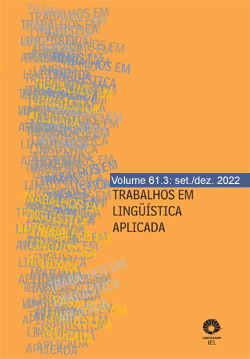Abstract
From its historical origins as a resistant and violently repressed bundle of music, dance and martial arts practices of the African diaspora in Brazil, capoeira has travelled, becoming a global phenomenon with groups and networks in diverse sites around the world, including London, Cape Town and Hong Kong and indeed Leeds where this research was based. We focus on the linguistic, cultural and embodied ensemble of capoeira, researching a capoeira group with diverse participants led by Sandro, a Brazilian contramestre, providing a rich laboratory for what has been called language learning “in the wild”, specifically of the Afro-Brazilian linguistic and cultural practices (music, movement, lyric, voice) that are a crucial element of the capoeira ensemble. These linguistic and cultural practices contingently bring together, in rehearsal and performance, the characteristic capoeira dance/martial arts movements, the pervasive regulation of rhythm and the apprenticeship of the body into its rhythm and movement. Seen from the perspective of informal language learning the capoeira group seems to constitute a near optimal context. We will explore the affordances of the capoeira group for linguistic/cultural/embodied learning of Afro-Brazilian Portuguese, drawing on the “maximalist” framework for translanguaging (BAYNHAM; LEE, 2019), which we extend to encompass the pervasive musical aspect of capoeira, linking these to contemporary perspectives on language learning, particularly informal language learning and language learning “in the wild”.
References
AGHA, A. (2003). The social life of cultural value. Language and Communication, v. 23, n. 3-4, p. 231-273.
AIDOO, L. (2018). Slavery unseen: sex, power and violence in Brazilian history. Durham: Duke University Press.
ALENCASTRO, L. F. D. (2019). The trade in the living. Albany: State University New York Press.
BAYNHAM, M.; LEE, T. K. (2018). Translation and Translanguaging. London: Routledge.
BLOCK, D. (2003). The Social Turn in Second Language Acquisition. Edinburgh: Edinburgh University Press.
CANAGARAJAH, S. (2018). Translingual Practice as Spatial Repertoires: expanding the paradigm beyond structuralist orientations. Applied Linguistics v. 39, n. 1, p. 31-54.
COBRA MANSA; ASSUNÇÃO, M. R. (2008). A dança da zebra. Rio de Janeiro: Revista de História da Biblioteca Nacional (30) , p. 14-21.
COHN, R. (1985). Deaths of Slaves in the Middle Passage. The Journal of Economic History, v. 45, n. 3, p. 685-692.
DE ABREU, F.J. (2005). Capoeiras: Bahia, Século XIX. Salvador: Instituto Jair Moura.
DELAMONT, S.; STEPHENS, N. (2008). Up on the roof: The embodied habitus of diasporic capoeira. Cultural Sociology 2(1), p. 57-74.
DELEUZE, G.; GUATTARI, F. (2013). A Thousand Plateaux. London: Bloomsbury.
ESKILDSEN, S. W.; THEODÓRSDÓTTIR, G. (2015). Constructing L2 learning spaces: Ways to achieve learning inside and outside the classroom. Applied Linguistics, p. 1-23.
ESPETO CAPOEIRA. (2022). Os Toques da Capoeira. Available from: https://capoeiraespeto.wordpress.com/2018/03/17/os-toques-da-capoeira Accessed: 18 September 2022.
GOMES, F. S. (2015). Mocambos e quilombos: uma história do campesinato negro no Brasil. São Paulo: Claro Enigma.
MARQUESE, R. B. (2006). A dinâmica da escravidão no Brasil. Novos Estudos (74), p.107-132.
MINISTÉRIO DAS RELAÇÕES EXTERIORES (MRE). (2020). Proposta curricular para o ensino de Português para praticantes de Capoeira. Brasília: FUNAG. Available from: https://funag.gov.br/biblioteca-nova/produto/21-1123-1 Acessed: 20 May 2022.
PENNYCOOK, A.; OTSUJI, E. (2015). Metrolingualism: Language in the city. London: Routledge.
PINHEIRO, A. (2022). Tipos musicais da capoeira: Ladainha, Chula, Corrido e Quadra. Available from: http://leonardogcb.blogspot.com/2010/11/tipos-musicais-da-capoeira-ladainha.html Accessed: 15 September 2022.
PORTAL CAPOEIRA (2022a). As Maltas da Capoeira | Portal Capoeira. Available from: https://portalcapoeira.com/capoeira/curiosidades/as-maltas-da-capoeira Accessed: 18 September 2022.
PORTAL CAPOEIRA. (2022b). Contramestre e não mestrando: Mestrando em Capoeira? | Portal Capoeira. Available from: https://portalcapoeira.com/capoeira/publicacoes-e-artigos/contramestre-e-nao-mestrandomestrando-em-capoeira/ Accessed: 18 September 2022.
ROBERTS, C.; BAYNHAM, M. (eds.). (2006). Special issue “Where talk is work: the social contexts of adult ESOL classrooms”, Linguistics and Education, v. 17, n. 1., p. 1-106.
RHODES, C.R; CLONAN-ROY, C.; WORTHAM, S. (2020) Making language academic: language ideologies, enregisterment and ontogenesis. Language and Education, v. 35, n. 6, p.522-538.
RYMES, B. (2014) Communicating beyond language: everyday encounters with diversity. New York: Routledge.
WHYATT, S.; BARBERIS, C.; PASCHOAL, A. (2020). Portuguese for Capoeiristas: Master the Basics in 16 Comprehensive Lessons based on Popular Capoeira Songs, 1st ed. Independently published.
SKIDMORE, T. E.; GREEN, J. N. (2021). Brazil: Five centuries of change. Oxon: Oxford University Press.
SLAVE VOYAGES. (2021). Available from: https://www.slavevoyages.org/ Accessed: 25 May 2022.
SNELL, J.; COPLAND, F.; SHAW, S. (2015). Linguistic Ethnography: Interdisciplinary Explorations. Basingstoke, New York: Palgrave MacMillan.
WAGNER, J. (2004). The Classroom and Beyond. The Modern Language Journal, v. 88, n. 4, (Special issue: Classroom Talks), p. 612-616.

This work is licensed under a Creative Commons Attribution 4.0 International License.
Copyright (c) 2022 Trabalhos em Linguística Aplicada


